Woolworth's SIT-DOWN STRIKE in 1937 Detroit:
Lessons for Today’s Low-Wage Workers
The original version of this article was published in Labor Notes on December 11, 2013.
See also Beyond Chron and Talking Union.
Copyright © 2013 Marc Norton
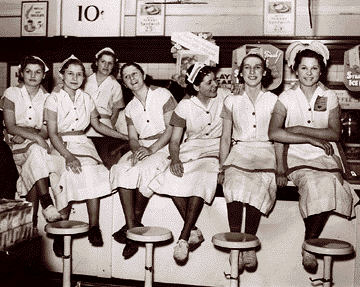 In 1937, Woolworth’s was the Walmart of its day. The company had transformed the retail marketplace by creating a national chain of stores staffed by low-wage workers, mostly young women. The lunch counters in these stores, serving inexpensive food, were in some ways a precursor to today’s fast food mega-corporations. In 1937, Woolworth’s was the Walmart of its day. The company had transformed the retail marketplace by creating a national chain of stores staffed by low-wage workers, mostly young women. The lunch counters in these stores, serving inexpensive food, were in some ways a precursor to today’s fast food mega-corporations.
So the story of a successful sit-down strike at a Woolworth’s in Detroit gives us some useful parallels for low-wage workers today. In the wake of the Walmart and fast food strikes on Black Friday and December 5, it is worth asking where the movement is going. What are its goals? How can they be achieved? Are workers getting organized for the long haul? Are we on a path to victory?
The Detroit sit-down electrified the nation at the time, but has been relegated to a footnote in mainstream history, even among labor historians. A recent pamphlet by history professor Dana Frank at the University of California at Santa Cruz (UCSC) should resurrect this history and its lessons.
NO ORDINARY SATURDAY
“On the surface it seemed like the most ordinary of Saturdays at the most ordinary of American institutions,” Frank begins. “It was February 27, 1937, at Woolworth’s Five and Dime store, the big four-story red brick one in downtown Detroit…
“Like all Woolworth’s stores, this one was painted with red and green trim, with the chain’s name out front in big bold letters,” displaying the company’s corporate brand identity in a way that was new at the time, though omnipresent today.
But it was not the “most ordinary of Saturdays.” General Motors auto workers in Flint, only a few miles north of Detroit, had won a historic victory just days earlier, after occupying their factory for several weeks, ignoring court orders to leave, and fighting off police assaults. It was in fact an "extraordinary moment in history."
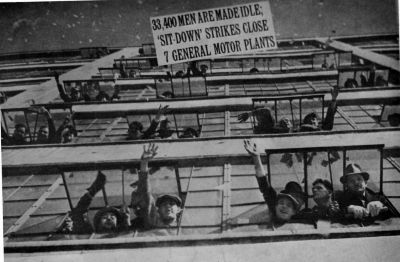 The workers had received so much sympathy and support that the governor actually sent in the National Guard to protect the strikers from the police. In the end, General Motors capitulated and recognized the then-fledgling United Auto Workers (UAW). Auto workers flooded into the UAW, helping to propel it and the new Congress of Industrial Organizations (CIO) to even greater victories. The workers had received so much sympathy and support that the governor actually sent in the National Guard to protect the strikers from the police. In the end, General Motors capitulated and recognized the then-fledgling United Auto Workers (UAW). Auto workers flooded into the UAW, helping to propel it and the new Congress of Industrial Organizations (CIO) to even greater victories.
Inside Woolworth’s was “a vast array of small, low-priced goods: hair combs, knitting needles, lampshades, safety pins, pie plates, face creams, and crisp new shoelaces folded into little packets, with paper bands around their middles specifying their length… Tidily printed signs poked up from displays throughout the store to reassure customers that almost all the goods splayed out in flat, tray-like counters at waist level cost only five or ten cents, just as the store’s name promised…
“The more intrepid could follow arrows luring them down into the basement sales level, complete with canaries. There, shoppers who were white could indulge in a banana split at the lunch counter.”
The women who staffed the store knew their place in the scheme of things. Frank Woolworth, the company’s founder, had put it bluntly:
“We must have cheap help or we cannot sell cheap goods.”
Bing Crosby provided a counterpoint with one of his hit songs —
“I Found a Million-Dollar Baby in a Five-and-Ten-Cent Store.”
STRIKE, GIRLS, STRIKE!
The young women in the Detroit Woolworth’s undoubtedly had their meager paychecks and the victory at Flint on their minds that Saturday morning. And then “Floyd Loew, an organizer with the Waiters’ and Waitresses’ Union of Detroit, strode to the very center of the store’s first floor… blew a screeching whistle as loud as he could and yelled ‘STRIKE! STRIKE!’ — or by some reports, ‘STRIKE, GIRLS, STRIKE!’
“Voices shouted out and cheers rose from different parts of the store. First the women in the white uniforms at the food counter stopped working. Then they moved quickly through the whole store, and soon almost all the women workers on all three sales floors had stepped back from their counters or rushed out from the kitchen, folded their arms, and stopped working.”
According to the Detroit News, “The jangle of cash registers stopped, and bewildered customers found themselves holding out nickels and dimes in vain… [But] not a girl tried to wait on a customer.”
Within minutes the store’s manager appeared. All the women, plus the stock boys, were ushered into a conference room.
The strikers gave the manager a list of demands: union recognition, a 10-cent per hour raise over their current 25 cents, an eight-hour workday, time-and-a-half after 48 hours per week, 50-cent lunches for the food counter workers, free uniforms and laundering, seniority rights, hiring of new workers only through a union hiring hall, and no retaliation.
The manager hemmed and hawed, but promised nothing. The strikers then said they would occupy the store until their demands were met.
“A hundred and eight ordinary young women had done a huge, astonishing thing: they were not only on strike, right in the depths of the Great Depression, but they were occupying the property of one of the largest transnational companies in the United States and refusing to leave until they won,” Frank writes.
“It was a classic sit-down strike, but for the first time the strikers were all women working in a variety store, not men in a factory. Within hours the eyes of the nation would be riveted on these young women and their strike. They had, after all, taken on one of the biggest corporate and consumer icons of the century, with two thousand stores in five countries — it was like striking Walmart, the Gap, and McDonald’s all at the same time.”
ORGANIZED TO STAY
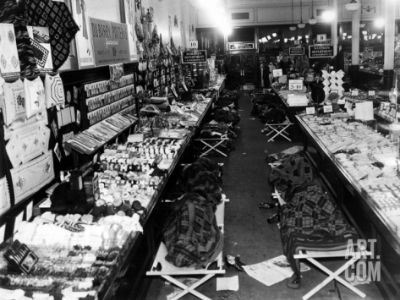 Frank tells us how the women organized themselves in the days ahead — using the store’s kitchen to prepare food, bringing in mattresses, keeping the store tidy using some of the on-hand cleaning supplies, occasionally helping themselves to candy and headache tablets — all the while partying pretty hard as well. The store’s three telephones were used to communicate with friends, supporters and the press. They even formed a “Cheer-Up Committee,” which “watched for the first curling lip and… soon had all sadness chased away.” Frank tells us how the women organized themselves in the days ahead — using the store’s kitchen to prepare food, bringing in mattresses, keeping the store tidy using some of the on-hand cleaning supplies, occasionally helping themselves to candy and headache tablets — all the while partying pretty hard as well. The store’s three telephones were used to communicate with friends, supporters and the press. They even formed a “Cheer-Up Committee,” which “watched for the first curling lip and… soon had all sadness chased away.”
On Monday, two days after the strike began, organizer Mira Komaroff with Local 705 of the Hotel Employees and Restaurant Employees met with some workers at a second, smaller Woolworth’s in downtown Detroit.
Before long, a second store had been occupied.
That night, Secretary-Treasurer Louis Koenig of Local 705 threatened Woolworth’s: if the strike was not settled by the following Saturday, he said, “I will ask the executive council of our association to call a national sit-down” at all Woolworth’s in the country.
That Koenig would do this was quite astonishing. He was known as a “typical, old-guard business unionist,” and led a union with all of about 600 workers at a few big downtown hotels and elite clubs. But the times called out for militant speeches, and he was happy to oblige.
SOLIDARITY FROM ALL OVER
As the strike escalated, solidarity efforts kicked in with a vengeance. Regular picketing of the stores was organized, in large part by local hotel workers. National labor leaders rushed to express support.
Telegrams hailing the women strikers flooded in from around the country, as did money for food and supplies and for the women themselves. Newspapers headlined the story; movie theaters showed newsreels. People were talking about the strike.
On Tuesday, the Retail Clerks’ International Protective Association in New York dispatched a telegram promising funds and saying the union would “open a boycott of the Woolworth stores in New York pending the outcome of the strike” at a demonstration Saturday — the same deadline Koenig had proclaimed.
In Detroit, other service workers got into the act. At Stouffer’s, 60 waitresses and kitchen workers occupied their restaurant on Tuesday in the middle of the lunch rush. Workers at Huyler’s Cafeteria in the Fisher Building sat down, then barricaded the doors. Unfortunately, Frank does not tell us the outcomes of these actions.
All the while, local store owners were falling over themselves to hand out wage increases in order to forestall more sit-downs.
On Wednesday, Woolworth’s finally agreed to negotiate. The workers were represented by Koenig, Louis Walters from the cooks union, and Louis Salter from the retail clerks — all men. None of the women strikers was present. Woolworth’s was represented by some big shots from New York.
The talks dragged on into Thursday, then Friday.
“Then, at 5:30 pm on Friday, March 5, the strike’s seventh day, just in time to avert Koenig's deadline for expanding the strike and to avoid the boycott in New York, Woolworth’s and the unions announced an agreement.”
VICTORY
“No question, it was an absolute and clear-cut victory for the strikers,” Frank reports. “They won an entire laundry list of demands, including the laundry. First, the company agreed to a five-cent an hour increase for all female employees… Everyone would get time and a half for overtime, after a 48-hour work week. Future workers would be hired through the union’s offices. Uniforms would be furnished and laundered by the company for free…
“And, most amazing of all, the women would be paid at 50% of their usual rate for the time they were occupying the store (though not, presumably, for 24-hour days)… Moreover, the agreement covered not just the two stores that had been taken over, but all forty Woolworth’s stores in the city.”
Woolworth’s got nothing but a promise that union workers wouldn’t harass non-union workers.
As word of the agreement spread, striking workers from both stores gathered inside the main store. They sang and cheered. When they went outside, they found more than a thousand people jamming the sidewalks. They marched to a local hotel, where Koenig read the agreement. Koenig didn’t bother to ask for a vote. Nobody seemed to care.
“On Saturday,” Frank writes, “Woolworth’s announced a special sale.”
The Woolworth’s strike produced a series of copycat actions. There were sit-down strikes at retail stores in Detroit, St. Louis, New York, and San Francisco — in Akron, Ohio; Superior, Wisconsin; St. Paul and Duluth, Minnesota; Tacoma and Centralia, Washington.
“Unions today… all over the country,” Frank writes, “owe their existence in part to the Woolworth’s strike.”
Frank sums it up this way:
“All this from a hundred and eight very young, entirely ordinary young women who one day in Detroit decided to stage a sit-down. That was the brilliance of it — it wasn’t some mythical superheroes who had pulled it off, but regular young women with no experience of striking, let alone of occupying a major chain store twenty-four hours a day for seven long days.
“They took on one of the biggest corporate powers of their time and won big, inspiring hundreds of thousands of other ordinary salesclerks — and who knows who else — to stand up (or sit down) for their rights, to claim a living wage… And they taught the arrogant Woolworth’s corporation an enormous lesson.”
LESSONS FOR TODAY?
Many articles would exit the story right now, trumpeting a tale of triumph over corporate greed. But that would teach us nothing except a bit of history. If we are to be equal to the tasks before us, we need to learn from history, draw the necessary conclusions, and act on them.
Franks states that "In retrospect, what they did looks simple, almost easy. But they could easily have lost."
Frank posits that the Woolworth’s workers won, first and foremost, because of “their own sense of audacity… and of faith in themselves.” I would add courage, closely related to audacity.
She also argues that “they won because they had an enormous array of powers behind them: the example of the General Motors workers [in the Flint sit-down strike], the force of public opinion, neutrality from the mayor and the governor, [and] spectacular solidarity from thousands of allies.”
Few would argue that these conditions exist today for the labor movement. Many are hoping that low-wage Walmart and fast food workers might become the example like the Flint workers. But we are certainly not there yet.
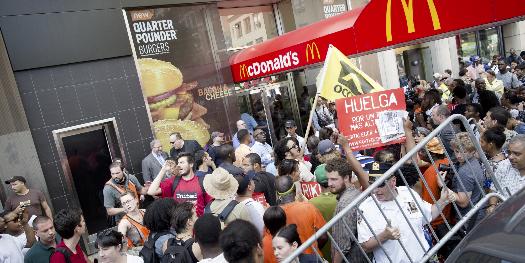 |
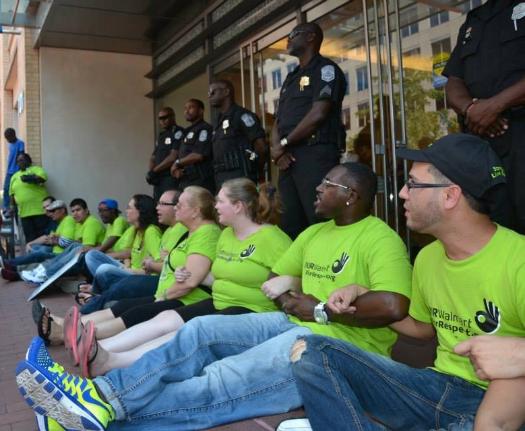 |
REPUBLIC WINDOWS & DOORS
Still, five years ago, in late 2008, more than 200 workers at Republic Windows & Doors in Chicago again raised the specter of sit-down strikes in the US.
The company was closing down. Bank of America, the company's main lender, had canceled its line of credit. Workers wages had not been paid, and they had been offered nothing except unemployment.
The workers responded by occupying the factory. They received a great deal of support, including a statement of solidarity from the newly-elected Barack Obama.
After several days, the union struck a $1.75 million deal to pay the workers back pay and benefits.
The company later reorganized and, after a second occupation in 2012, is now a co-operatively owned enterprise. Just a few days ago, the former CEO of the company, Richard Gillman, struck a plea deal with Chicago prosecutors over criminal charges that he had looted the company of more than $10 million, and was sentenced to four years in prison.
Many had hoped that the successful sit-down strikes at Republic Windows & Doors would become a model for the labor movement. It hasn't happened. Why not? The story of the workers at Republic Windows & Doors begs to be told and retold, just like the story of the brave women at Woolworth's in Detroit.
The story of the the first occupation at Republic Windows & Doors has been ably told by Michael Moore in his film, Capitalism: A Love Story.
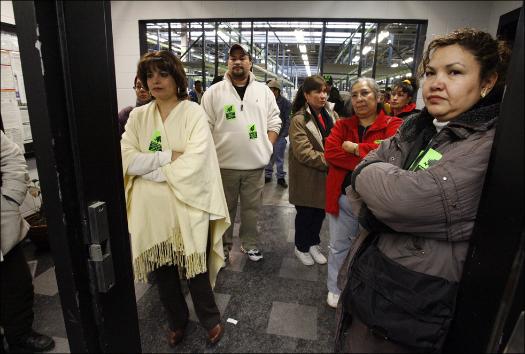 |
VICTORY LOST
The Woolworth’s victory was, sadly, fleeting.
In an epilogue, Frank notes that “The Detroit Woolworth’s workers lost their union contract when it came up for renewal in October 1937,” just a few months after their victory.
“As individual women left the store,” Frank tells us, “management deliberately replaced them with anti-union workers who didn’t then fight to keep the union.”
There is obviously a story of its own here, including why the union failed to enforce the agreement that required hiring to come through the union. Frank doesn't tell us more, but it is not hard to imagine how an anti-union campaign by the Woolworth bosses, a union unable or unwilling to hold them to account, and the transitory nature of low-wage work could take their toll.
Sort of a like a fairy tale where everybody lives happily ever after, but only for a little while.
One has only to look at the nightmare that Detroit is today for working class people to understand that a victory is never final — at least not while capital rules.
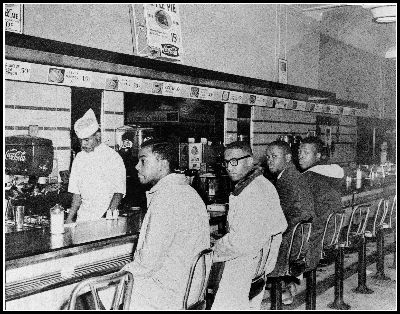 Ironically, Woolworth lunch counters would become the scene of yet another triumphant fight involving sit-ins in 1960 — this time by Black folks and their allies, demanding the right to eat at them. That fight was won, or so the received wisdom goes. But look again at Detroit, today over 80% Black, and that victory seems a lot less than what it is cracked up to be, even with a Black president in the White House. Ironically, Woolworth lunch counters would become the scene of yet another triumphant fight involving sit-ins in 1960 — this time by Black folks and their allies, demanding the right to eat at them. That fight was won, or so the received wisdom goes. But look again at Detroit, today over 80% Black, and that victory seems a lot less than what it is cracked up to be, even with a Black president in the White House.
VICTORIES TO COME?
Workers and exploited people everywhere fight back. That happens whether unions, activists and politicos organize it or not. Rebellion is a fact of life. But to make rebellion into victory, and to maintain that victory, takes organization, plus vision and daring. And that means a lot more than Facebook postings, Twitter feeds, press releases, and the assorted media hype.
The Woolworth strikers were organized to fight in the conditions in which they lived. They fought hard and well. They won. Their audacity and courage can be an inspiration to us all, especially to low-wage workers.
But the lessons of the failure to hold on to that victory need to be learned also.
That one simple word from the great Joe Hill sums it up — "Organize!"

|